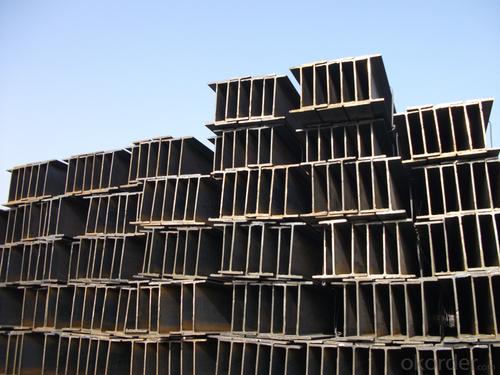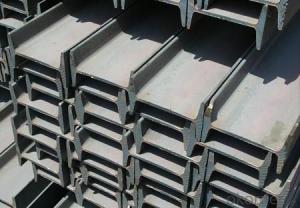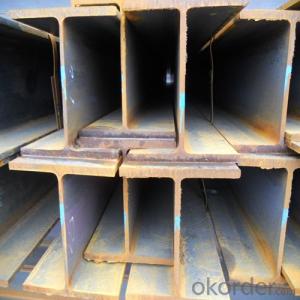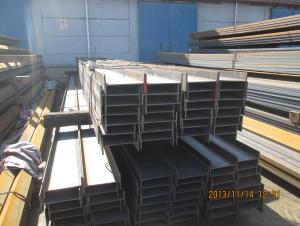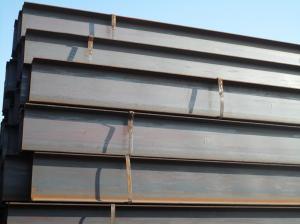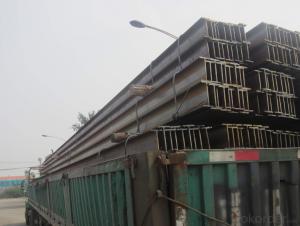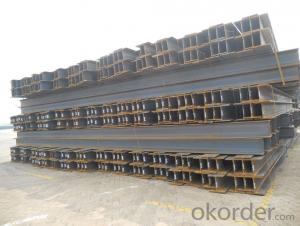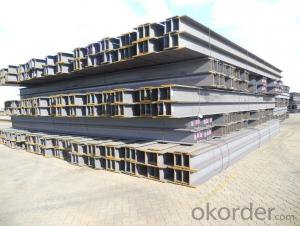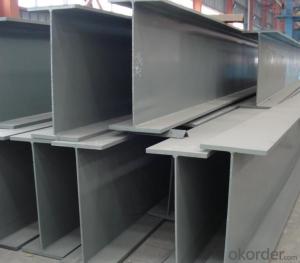Steel H Beams JIS Beams Hot Rolled with Low Carbon
- Loading Port:
- Tianjin
- Payment Terms:
- TT or LC
- Min Order Qty:
- 100 m.t.
- Supply Capability:
- 25000 m.t./month
OKorder Service Pledge
OKorder Financial Service
You Might Also Like
OKorder is offering Steel H Beams JIS Beams Hot Rolled with Low Carbon at great prices with worldwide shipping. Our supplier is a world-class manufacturer of steel, with our products utilized the world over. OKorder annually supplies products to African, South American and Asian markets. We provide quotations within 24 hours of receiving an inquiry and guarantee competitive prices.
Product Applications:
Steel H Beams JIS Beams Hot Rolled with Low Carbon are ideal for structural applications and are widely used in the construction of buildings and bridges, and the manufacturing, petrochemical, and transportation industries.
Product Advantages:
OKorder's Steel H Beams JIS Beams Hot Rolled with Low Carbon are durable, strong, and wide variety of sizes.
Main Product Features:
· Premium quality
· Prompt delivery & seaworthy packing (30 days after receiving deposit)
· Can be recycled and reused
· Mill test certification
· Professional Service
· Competitive pricing
Product Specifications:
Manufacture: Hot rolled
Grade: Q195 – 235
Certificates: ISO, SGS, BV, CIQ
Length: 6m – 12m, as per customer request
Packaging: Export packing, nude packing, bundled
SIZE(mm) | DIMENSION(kg/m) |
100*100 | 16.9 |
125*125 | 23.6 |
150*75 | 14 |
150*150 | 31.1 |
148*100 | 20.7 |
198*99 | 17.8 |
200*100 | 20.9 |
248*124 | 25.1 |
250*125 | 29 |
300*150 | 36.7 |
298*149 | 32 |
200*200 | 49.9 |
294*200 | 55.8 |
346*174 | 41.2 |
350*175 | 49.4 |
244*175 | 43.6 |
175*175 | 40.4 |
294*200 | 55.8 |
298*201 | 64.4 |
346*174 | 41.2 |
350*175 | 49.4 |
400*200 | 65.4 |
396*199 | 56.1 |
450*200 | 74.9 |
446*199 | 65.1 |
340*250 | 78.1 |
500*200 | 88.1 |
300*150 | 36.7 |
FAQ:
Q1: Why buy Materials & Equipment from OKorder.com?
A1: All products offered byOKorder.com are carefully selected from China's most reliable manufacturing enterprises. Through its ISO certifications, OKorder.com adheres to the highest standards and a commitment to supply chain safety and customer satisfaction.
Q2: How many tons of steel products could be loaded in containers?
A2: Usually the steel products are delivered by bulk vessel because of the large quantity and the freight. However, there are no bulk vessel enter some seaports so that we have to deliver the cargo by containers. The 6m steel product can be loaded in 20FT container, but the quantity is changed according to the size, usually from 18tons to 25tons.
Q3: what is the difference between actual weight and theoretical weight?
A3: All the section steel has two weights: actual weight and theoretical weight. Actual weight is the weighing out when the product delivered from the mill. Theoretical weight is calculated by pieces. The invoice can be based on each of them as your request.
Images:
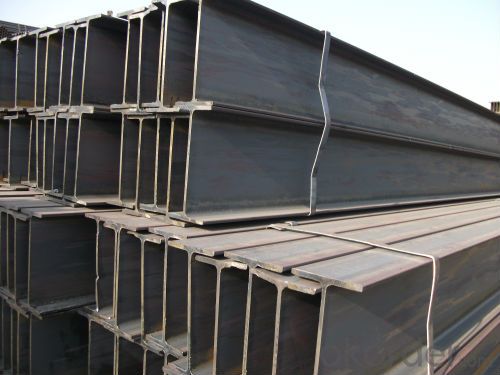
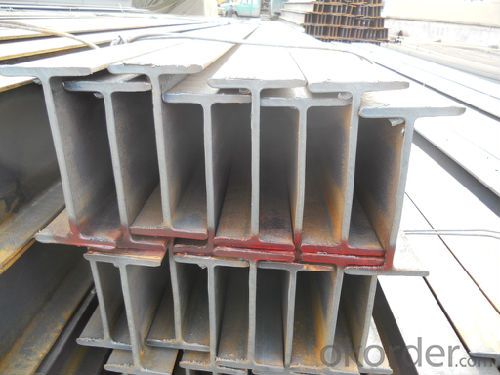
- Q: How do steel H-beams perform in bridge expansions or contractions?
- Steel H-beams are widely used in bridge construction due to their excellent performance during expansions or contractions. These beams have high tensile strength and flexibility, allowing them to withstand the forces caused by temperature variations. As the bridge expands or contracts due to temperature changes, the steel H-beams can adjust their shape accordingly without compromising the structural integrity of the bridge. This ability to accommodate thermal movements makes steel H-beams an ideal choice for bridges, ensuring their stability and longevity over time.
- Q: What are the different types of connections used for steel H-beams in multi-story buildings?
- There are several types of connections commonly used for steel H-beams in multi-story buildings. Some of these include bolted connections, welded connections, and composite connections. Bolted connections involve using bolts and nuts to join the beams together, providing flexibility and ease of installation. Welded connections involve melting and fusing the beams together using heat, creating a strong and rigid connection. Composite connections combine both bolted and welded connections, utilizing the advantages of both methods to achieve optimal strength and performance. The choice of connection type depends on various factors, such as design requirements, structural loadings, and construction methods.
- Q: H how long is the length of the steel section?
- Hot rolled H steel is usually fixed length of 12 meters or less, if it is welded H steel can reach 20 meters or longer, hot-rolled H steel is too long, transportation is not convenient
- Q: Are steel H-beams prone to bending or warping?
- Steel H-beams are not prone to bending or warping due to their high strength and rigidity. They are designed to withstand heavy loads and provide structural stability, making them a reliable choice for construction and engineering purposes.
- Q: Can steel H-beams be used in the construction of exhibition halls or convention centers?
- Indeed, exhibition halls and convention centers can make effective use of steel H-beams in their construction. These beams are widely utilized in the field of construction due to their remarkable strength and durability. They offer exceptional structural support and have the ability to bear heavy loads, rendering them highly suitable for the construction of expansive buildings such as exhibition halls and convention centers. The H-shape of these beams guarantees enhanced stability and resistance against bending, making them a perfect choice for the creation of wide-span structures. Moreover, steel H-beams can be easily manufactured and installed, resulting in time and cost savings during the construction process. Consequently, steel H-beams have gained significant popularity as a reliable and robust framework for the construction of exhibition halls and convention centers.
- Q: Can steel H-beams be used in mezzanine floor construction?
- Indeed, it is possible to employ steel H-beams in the construction of mezzanine floors. These H-beams, alternatively referred to as I-beams or universal beams, are frequently utilized in the field of construction owing to their impressive strength and ability to bear heavy loads. Mezzanine floors, which serve as intermediate levels between a building's primary floors, often necessitate the use of steel beams to support the added weight and ensure structural stability. Opting for steel H-beams in mezzanine floor construction is a highly recommended choice due to their capacity to endure substantial loads and provide enduring durability.
- Q: Can steel H-beams be used in multi-story buildings?
- Indeed, it is possible to utilize steel H-beams in multi-story buildings. These beams are frequently employed in the construction field as a result of their exceptional strength, long-lasting nature, and ability to bear heavy loads. By offering structural support and stability, they prove to be an excellent option for constructing buildings with multiple levels. Moreover, the fabrication and installation of steel H-beams are effortless, thus promoting efficient construction practices. Architects and engineers highly favor them due to their adaptability and capacity to endure substantial weights when it comes to erecting skyscrapers.
- Q: Are steel H-beams resistant to fire?
- Yes, steel H-beams are highly resistant to fire. Due to their high melting point and excellent structural integrity, steel H-beams can withstand high temperatures and maintain their strength even during a fire. This makes them a popular choice for structural support in buildings and other fire-prone environments.
- Q: What are the main parts of hot-rolled H steel? What kind of project is required to use H steel, and what kind of customer base is best to find when selling H steel?
- The use of H steel in industrial and civil buildings not only saves labor, reduces costs, but also reduces the amount of steel used. For example, the steel structure of the mill is reduced by 15%-20% by comparing the amount of steel used between hot-rolled I-beam and hot-rolled wide flange H steel.
- Q: Can steel H-beams be used for agricultural storage buildings?
- Yes, steel H-beams can be used for agricultural storage buildings. Steel H-beams are commonly used in construction due to their strength and durability. They provide excellent structural support and can withstand heavy loads, making them suitable for storing agricultural equipment, machinery, and produce. Additionally, steel buildings are resistant to pests, fire, and adverse weather conditions, making them a reliable choice for agricultural storage.
Send your message to us
Steel H Beams JIS Beams Hot Rolled with Low Carbon
- Loading Port:
- Tianjin
- Payment Terms:
- TT or LC
- Min Order Qty:
- 100 m.t.
- Supply Capability:
- 25000 m.t./month
OKorder Service Pledge
OKorder Financial Service
Similar products
Hot products
Hot Searches
Related keywords



